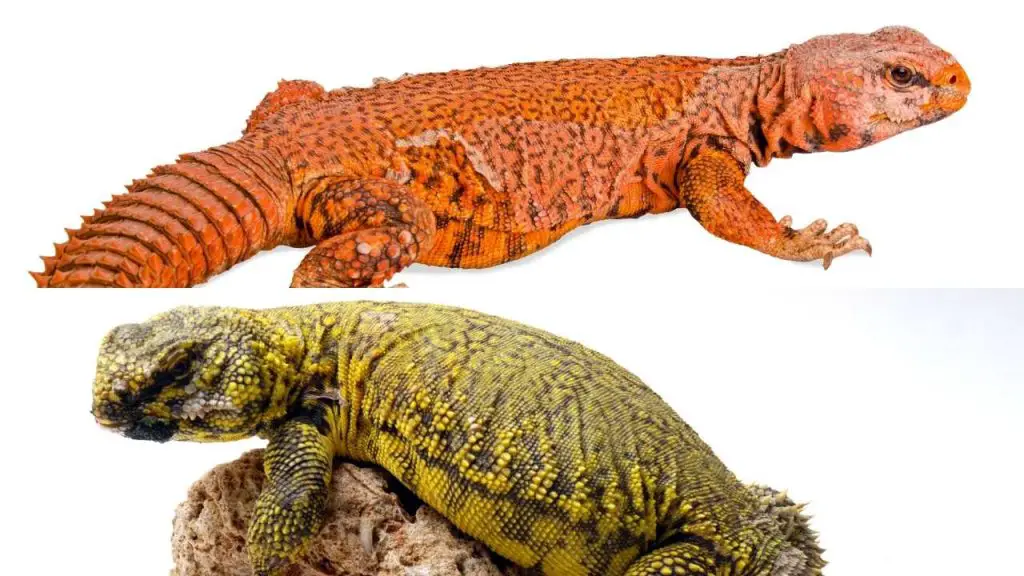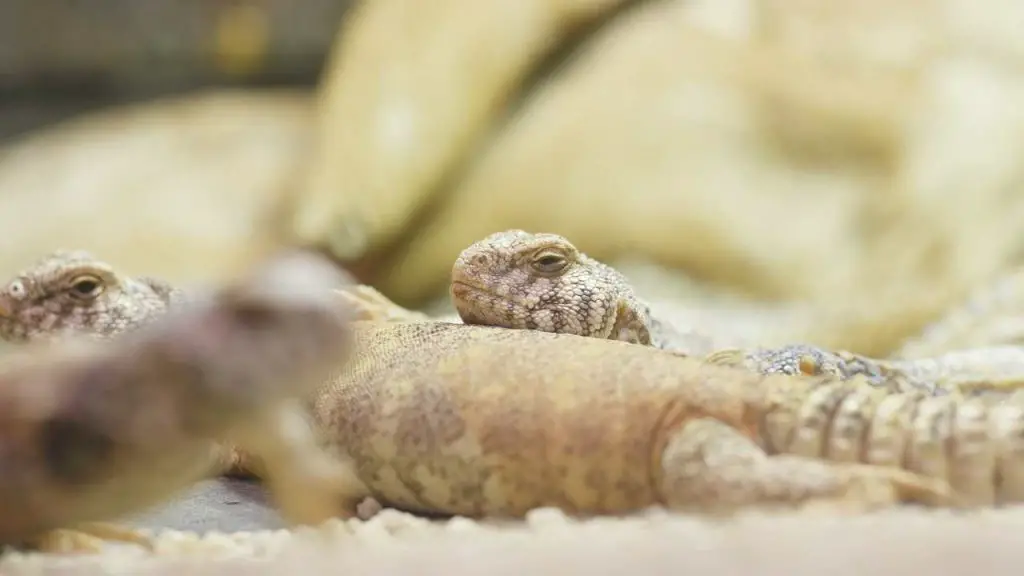Heard about the spiny-tailed lizard? Or are you fascinated by pet reptiles?
Then an Uromastyx – a genus of African and Asian agamid lizards – might be your perfect choice! Uromastyx has skyrocketed in popularity over the last few years largely because they’re so easy to care for, look so beautiful, and are fun to handle. But they still are pets!
Being a pet owner requires knowledge, planning, responsibility, and loads of care. You need to work out how you will accommodate it in your house, in what ways it will be a part of your life, what you will feed it, where it will live, and most importantly, how much space it will take.
We can’t walk with you throughout the entire experience, but we sure are here to make your first steps easier!
In order to gauge how much space you need for your pet, you first need to know how big do uromastyx get become with the passage of time. That’s where we come in!
Once you’re done and dusted with this article, you’ll be way more confident about making the right decisions.
This article has been reviewed by Dr. Gospel. Read more about our knowledge control process here.
Contents
How Big Do Uromastyx Get?

All hatchlings start at about 2-4 inches long. However, for next few months, uromastyx has a noticeable growth speed and can get as long as 8-16 inches.
The average adult uromastyx size is anywhere between 8 to 10 inches depending on the care you provided and how well your pet received it. Proper thermoregulation triggers their basal metabolism that aids in the growth of uromastyx.
Although one major exception is the Egyptian Uromastyx, which can exceed even 30 inches in length.
How Fast Do Uromastyx Grow? Uromastyx Growth Rate!
It roughly takes three to five years for a Uromastyx to grow to its maximum size.
However, Egyptian Uromastyx is out of the ordinary! They can grow at an astonishing rate in the first few years. If you have a small tank for your baby uromastyx, you might need a new one very soon with growing inches every month.
Uromastyx Size Chart
| Length (Inches) | Age |
| 3-4 | 0-1 month |
| 5-9 | 2 months |
| 8-11 | 3 months |
| 9-12 | 4 months |
| 11-16 | 5 months |
| 11-18 | 6 months |
| 13-20 | 8 months |
| 16-22 | 1 year |
| 16- 26 | 2 years |
| 18-30 | 3 years |
| 30+ (Egyptian Uromastyx Species Only) | 3-5 years |
Uromastyx Weight

The average weight of an adult Uromastyx is approximately 450 grams. It may continue to grow along with increasing age.
Uromastyx Weight Chart
| Weight (grams) | Age |
| 2-3 | 0 months |
| 10-60 | 1 month |
| 70-200 | 2-4 months |
| 250-320 | 4-6 months |
| 310-420 | 8-10 months |
| 450-500 | 1 year |
| 500+ | 1 year onwards |
How to Tell If a Uromastyx Is Overweight
A stitch in time saves nine. Sounds familiar, right?
Being overweight Uromastyx is a risk itself. With obesity comes underlying health issues which may aggravate something critical.
If your lizard falls around the range of 800 -1500 grams, then it is most likely to be overweight.
Other signs of an obese Uromastyx include
- Thicker tail size than that of head
- Slow movements
- Decreased willingness to locomote
- Thicker legs, neck, and slow walks are other signs of obesity
However, you might confuse a gravid reptile with an overweight one. A gravid reptile will be more than a year old and may look uneasy.
To be certain, try to measure the weight of a lizard since the day it hatched. The weekly or monthly analysis gives the entire picture.
How to Tell If a Uromastyx Is Underweight
Normal weight tells a lot about the health of Uromastyx.
A skinny or underweight Uromastyx might be experiencing some health issues.
A slim body with visible bones and lethargy are signs of an underweight lizard. You may observe the following signs in an underweight lizard:
- Droopy skin
- Bones bulging out
- Tail and its base is too lean and flat,
- Slim thighs
- Stick thin neck
- It might struggle with locomoting, shaking, and dragging things.
You may offer leafy greens sprinkled with edible seeds like sesame. Moreover, you may supplement its diet with bee pollen once a while. Greens, vitamins, probiotics, and supplements in the diet can help an underweight lizard.
Record its weight and observe the bowel for any parasites and hydrate it well.
How Long Does Uromastyx Get?
Uromastyx can get from 10 to 36 inches long, depending on their species. The sizes are different for every species and they fall within the given range.
The smallest Uromastyx Hardwickii grows up to 10 inches when fully grown; whereas, the largest Egyptian Uromastyx may attain the size of 3 feet.
Why Isn’t My Uromastyx Growing or Gaining Weight?
Indeed, ignorance is bliss. But, not always!
Your Uromastyx showing signs of stunted growth may be because of several reasons.
But don’t worry!
We are here to help you out until you get a clear picture of what is possibly going wrong.
Here, we have enlisted some of the probable causes of stunted growth in Uromastyx.
Uromastyx Growth Problem #1: Inadequate UVB Exposure
UVB-lights installation compensates for sunlight.
Uromastyx needs UVB lights to help them make Vitamin D and in the proper absorption of calcium. As they are in captivity, they need light for basking too.
Under inadequate UVB exposure, Uromastyx becomes generally unhappy. The stress may affect its diet and movement. It may even stop eating and begin to hide.
Therefore, with little or no submission to UVB lighting, the Uromastyx may develop Vitamin-D deficiencies, stressful behaviors, and reduced diet-intake.
Decreased exposure may also cause the lizard to develop Metabolic Bone Disease (MBD). MBD causes the bones of reptiles to become deformed and brittle. The presence of too much phosphorus can also affect the normal growth of lizards.
This may, certainly, halt the overall growth of your pet.
Uromastyx Growth Problem #2: Insufficient Diet
The primary reason for your Uromastyx not gaining weight at all is insufficient diet.
Feeding practices may influence the digestive system of Uromastyx.
Generally, a lizard under four years should be fed daily. An older lizard may need to be fed 3 to 6 times a week, depending on its physique. This leads to better gastro-intestinal health that serves to enhance appetite.
Moreover, loss of appetite will most likely stop the lizard from growing. It may occur due to improper housing, parasitic infections, protein deficiencies, and dehydration. They are herbivores, so focus on the vegiies, greens, and fruits. Lack of herbivore food in the diet can lead to weakness and weight loss.
Gravid reptiles may show disinterest in ingesting food for a little while. Also, your pet may starve itself if the food offered doesn’t match its preferences.
You may overcome the dietary issues by offering vegetable mixes. Leafy greens with vegetables like parsley carrots, zucchini, cucumber, peas, and beans, etc., can be tempting for your pet.
It is essential to utilize a powdered calcium supplement (lacking phosphorus). Gently drizzle it over food each week about 1-2 times. If required, a multivitamin can be offered but less frequently: once or twice a month will do.
You may offer it fruits once in a while.
Consult a vet if the condition persists.
Uromastyx Growth Problem #3: Brumation
Uromastyx species undergo brumation in cold seasons.
They become generally sluggish, lose appetite, and mostly sleep. It’s not the same as hibernation as it does show some little activity. It comes out to eat, then bask for a while and go back to sleep.
These lizards tend to eat less in winters, as they are constructed that way.
If your pet is maintaining its weight in the state of brumation, there is no need to worry.
Uromastyx Growth Problem #4: Disease or illness
Parasitic Infections:
An important causative agent of stunted growth of an Uromastyx is a parasitic infection.
Your pet may experience uneasiness passing out and blood will be present in stool, accompanied by diarrhea and muscular wasting.
Parasitic infections can be triggered by both types of parasites: endoparasites and ectoparasites. The parasites not only suck the food reptiles eat but also deteriorate body functioning. This results in loss of nutritional content in the body, hence retarded growth and loss of appetite.
Parasites are transmitted from the feces of one reptile to the other. Therefore, try to keep one lizard in the enclosure as the risk of contracting infection increases.
Impaction:
In unfortunate events, if an Uromastyx ingests indigestible matter, it causes impaction.
It is, most of the time, caused when the lizard devours sand or foreign objects.
Due to impaction, the lizard will experience intestinal blockage, difficulty in passing out stool, and loss of appetite. This condition may render reduced or no growth.
A lizard experiencing such symptoms should be taken to the vet immediately.
To prevent impaction from occurring, avoid using sand as substrate, and keep your pet hydrated enough.
High Protein Diet:
Loading your pet with proteins can be very dangerous.
Excess intake of proteins can affect health drastically, as it induces kidney and liver malfunctioning. The liver and kidneys begin to overwork to metabolize high levels of proteins.
To avoid this, keep the protein-rich diet under a certain limit. Abstain from giving a diet rich with legumes and beans.
Wrapping Up How Big Do Uromastyx Get
Taking care of Uromastyx may seem complicated at first, but the efforts are worth it.
These lizards observe and appreciate the care administered and develop compassion for the owner.
After all, well begun is half done!